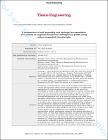| dc.contributor.author | KELLY, DANIEL | en |
| dc.contributor.author | BUCKLEY, CONOR | en |
| dc.date.accessioned | 2015-01-05T10:17:41Z | |
| dc.date.available | 2015-01-05T10:17:41Z | |
| dc.date.issued | 2014 | en |
| dc.date.submitted | 2014 | en |
| dc.identifier.citation | Mesallati T, Buckley CT, Kelly DJ, A comparison of self-assembly and hydrogel encapsulation as a means to engineer functional cartilaginous grafts using culture expanded chondrocytes., Tissue engineering. Part C, Methods, 20, 1, 2014, 52-63 | en |
| dc.identifier.issn | 1937-3384 | en |
| dc.identifier.other | Y | en |
| dc.identifier.uri | http://hdl.handle.net/2262/72875 | |
| dc.description | PUBLISHED | en |
| dc.description.abstract | Despite an increased interest in the use of hydrogel encapsulation and cellular self-assembly (often termed "self-aggregating" or "scaffold-free" approaches) for tissue-engineering applications, to the best of our knowledge, no study to date has been undertaken to directly compare both approaches for generating functional cartilaginous grafts. The objective of this study was to directly compare self-assembly (SA) and agarose hydrogel encapsulation (AE) as a means to engineer such grafts using passaged chondrocytes. Agarose hydrogels (5 mm diameter × 1.5 mm thick) were seeded with chondrocytes at two cell seeding densities (900,000 cells or 4 million cells in total per hydrogel), while SA constructs were generated by adding the same number of cells to custom-made molds. Constructs were either supplemented with transforming growth factor (TGF)-β3 for 6 weeks, or only supplemented with TGF-β3 for the first 2 weeks of the 6 week culture period. The SA method was only capable of generating geometrically uniform cartilaginous tissues at high seeding densities (4 million cells). At these high seeding densities, we observed that total sulphated glycosaminoglycan (sGAG) and collagen synthesis was greater with AE than SA, with higher sGAG retention also observed in AE constructs. When normalized to wet weight, however, SA constructs exhibited significantly higher levels of collagen accumulation compared with agarose hydrogels. Furthermore, it was possible to engineer such functionality into these tissues in a shorter timeframe using the SA approach compared with AE. Therefore, while large numbers of chondrocytes are required to engineer cartilaginous grafts using the SA approach, it would appear to lead to the faster generation of a more hyaline-like tissue, with a tissue architecture and a ratio of collagen to sGAG content more closely resembling native articular cartilage. | en |
| dc.format.extent | 52-63 | en |
| dc.language.iso | en | en |
| dc.relation.ispartofseries | Tissue engineering. Part C, Methods | en |
| dc.relation.ispartofseries | 20 | en |
| dc.relation.ispartofseries | 1 | en |
| dc.rights | Y | en |
| dc.subject | 3D Cell Culture | en |
| dc.title | A comparison of self-assembly and hydrogel encapsulation as a means to engineer functional cartilaginous grafts using culture expanded chondrocytes. | en |
| dc.type | Journal Article | en |
| dc.type.supercollection | scholarly_publications | en |
| dc.type.supercollection | refereed_publications | en |
| dc.identifier.peoplefinderurl | http://people.tcd.ie/kellyd9 | en |
| dc.identifier.peoplefinderurl | http://people.tcd.ie/cbuckle | en |
| dc.identifier.rssinternalid | 98469 | en |
| dc.identifier.doi | http://dx.doi.org/10.1089/ten.TEC.2013.0118 | en |
| dc.rights.ecaccessrights | openAccess | |
| dc.subject.TCDTheme | Next Generation Medical Devices | en |
| dc.identifier.orcid_id | 0000-0003-4091-0992 | en |




